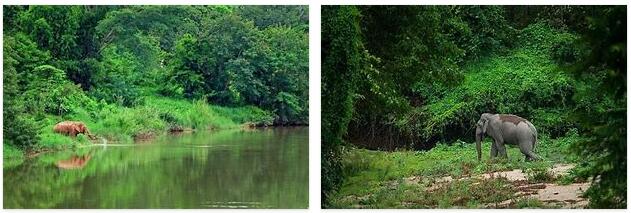Wildlife sanctuaries in Thailand (World Heritage), an ecosystem in the transition between subtropics and tropics is protected in the two nature parks on the border with Myanmar on an area of over 6200 km².
All forest types of East Asia can be found here. They are habitat for elephants and tigers, among others.
Wildlife Sanctuaries in Thailand: Facts
| Official title: | Thung Yai-Huai Kha Khaeng Wildlife Sanctuary |
| Natural monument: | Thung Yai Naresuan nature reserve with 3200 km² the largest of its kind in Thailand, with the adjacent Huai Kha Khaeng nature reserve the largest nature reserve on the Southeast Asian mainland, total area of 6222 km²; Heights of 250 m to the summit of Khao Thai Par with 1811 m; the name “Thung Yai” means “large field” and refers to the central large grass plain, catchment area of 4 important rivers, including the Mae Khlong, which flows into the Khwae Yai (“The Bridge on the Kwai”!); Karst formations with collapse funnels that are up to 2 km long; within the Karen and Hmong Villages Protected Area, a total habitat for about 3800 people |
| Continent: | Asia |
| Country: | Thailand |
| Location: | southern foothills of the Dawna Range, on the border with Myanmar (Burma) |
| Appointment: | 1991 |
| Meaning: | a relatively intact ecosystem in the transition between subtropics and tropics with all forest types of Southeast Asia |
| Flora and fauna: | 7 types of vegetation, including Mountain rain, bamboo, dry, gallery and so-called narrow forest with Dipterocarpaces, occurring tree species, etc. Burmese ironwood tree (Xylia xylocarpa) and Terminalia chebula; 120 species of mammals, 400 species of birds, 96 species of reptiles, 43 species of amphibians and 113 species of freshwater fish; large mammals such as tigers, clouded leopards, leopards, tapirs, the Sumatran rhinoceros as the most original and at the same time smallest rhinoceros species, the serau, a relative of the chamois, the cattle species Banteng and Gaur as well as water buffalo |
Southeast Asian eco diamonds
The area of the Thung Yai and Huai Kha Khaeng game reserves is already remarkable: at over 6,000 square kilometers, they are more than twice the size of the Saarland. According to softwareleverage, around a quarter of all mammal species in Thailand and more than a third of the native bird species live in the gallery and dry forests there, on the grassy areas and in the narrow forest. The only remaining herd of wild water buffalo roams the wet meadows of Huai Kha Khaeng. A few years ago, at least, this sanctuary was also the habitat of the largest herd of Gaur ever observed in Thailand – with a shoulder height of around two meters, the most powerful wild cattle in East Asia. However, since there are no current systematic animal observations and censuses, nothing is known about their population today.
Of course there are elephants that make their way through the thicket. The presence of the mighty tiger, which also attacks adult Gaurbullen, the slender leopard and the clouded leopard, which has large patches of fur and, like the long-tailed cat, is a climbing acrobat, is rather unexpected. Just as rarely do you see a hairy Sumatran rhinoceros equipped with two nasal horns or a contrasting saddleback tapir.
According to the travel writer Ernst von Hesse-Wartegg in 1899, “the great fauna that one encounters at every turn without having to look for it,” which can delight or frighten, irritate the palate, bite and sting, “can today, however, can only be spoken of with restrictions.
The west of Thailand, in which the Thung Yai and Huai Kha Khaeng protected areas are located, is comparatively untouched and still forty percent forested. Geologically, the region is characterized by the foothills of the eastern Himalayas reaching deep to the south. Its valleys and watercourses bring together the fauna of the north and south, of the mountains and plains.
In the necklace of the nature parks and other protected areas lined up in this border area to Myanmar, Huai Kha Khaeng and Thung Yai are the “diamonds” with a multifaceted flora and fauna and all the forest forms that predominate in Thailand.
Both over the grassland and the dense canopy of leaves, birds of prey have control of the air during the day and huge flocks of bats with 60 different species at night. From the height of the giant trees, the sedate “wosk, wosk, wosk” sounds, which is created by the flapping of the two-meter-large wings of a huge hornbill. With up to 200 figs in its crop, the imposing bird returns to the nesting cavity, which is high in the trees and walled up to protect against predators, to provide food for the females and brood. Meanwhile, bell-deer let their characteristic “bark” be heard. With their height of only 50 centimeters, they are almost invisible between tall grass and bushes.
Dense undergrowth is not typical for tropical primary forests. What grows here is on the way up. Epiphytes, “perched plants”, including ferns and orchids, have withdrawn from this striving for light from the start and spend their entire lives in the tops of the trees. Among the thousands of tree species in the tropical forests of Indochina, the rattan palm, a “climbing palm” that uses razor-like thorns to climb up other plants and trees, is a valued material for making wicker furniture. The elegant Indian darter hunts at the edges of the stately gallery forests along the watercourses: only the head and neck protrude from the water while he seeks his chance to spear unsuspecting fish with his beak.
